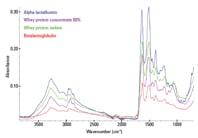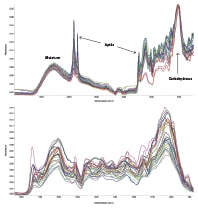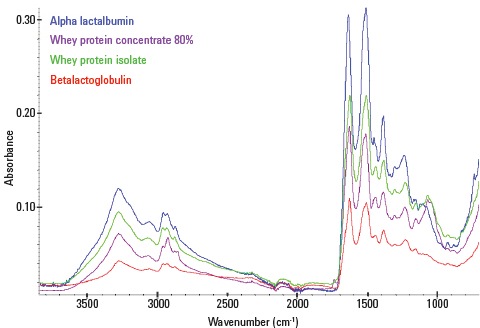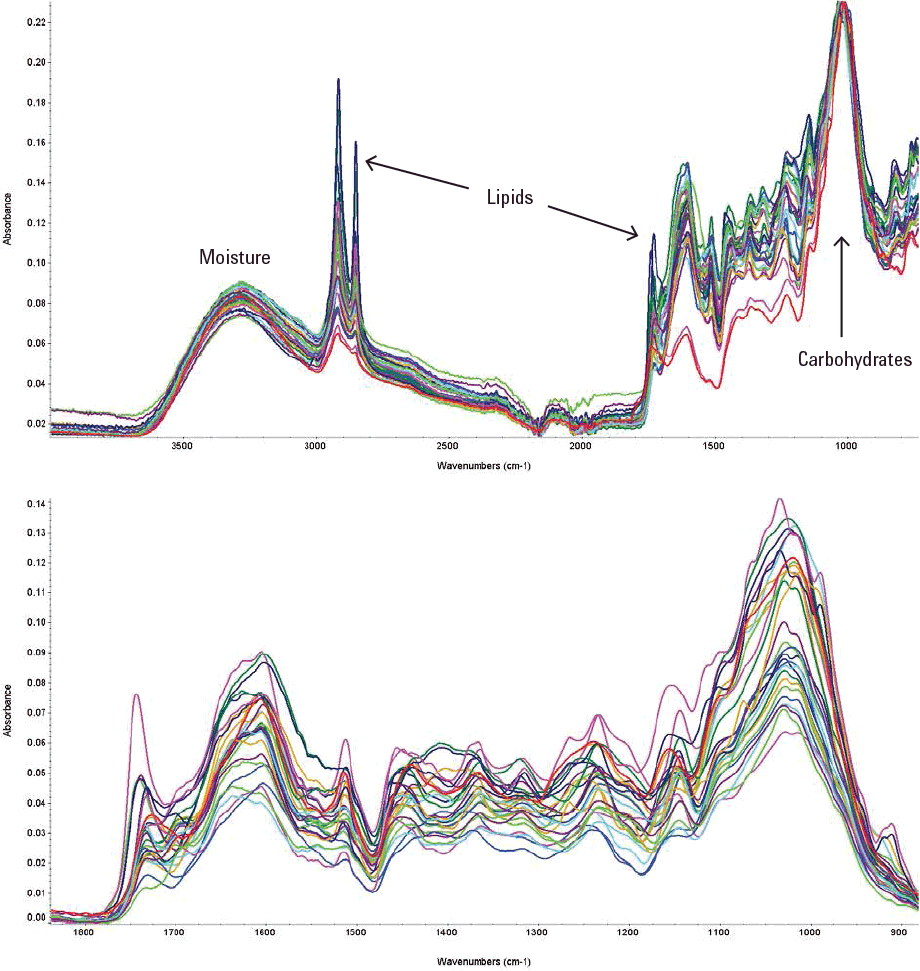Access Agilent eNewsletter, April 2014
>> Update My Profile | Subscribe to Access Agilent | Article Directory

Agilent FTIR solutions for food authenticity
By Zubair Farooq and Ashraf A. Ismail
McGill University, Montreal, Canada
Widespread globalization has increased the pressure to meet stringent standards for quality, safety, and cost effectiveness throughout the food production chain – including incoming inspection, new product development, and packaging. Fourier transform infrared spectroscopy (FTIR) has significant value in ensuring the quality of food and food ingredients, with short analysis times, limited sample preparation, and the ability to determine molecular structure. This technique identifies, verifies, and authenticates food and food ingredients.
Here we discuss a couple of examples of the use of FTIR for food authentication, taken from both established and emerging applications found in the Agilent Molecular Spectroscopy Compendium. Next month we’ll describe the use of ICP-MS for food authentication.
 Enlarge
Enlarge
Figure 1. Infrared spectra of dairy powders recorded on the Agilent Cary 630 ATR-FTIR analyzer.
Authenticating dairy powders
Dairy powders are used extensively as functional ingredients in many food products. Their composition can be highly variable in terms of proteins, carbohydrate (normally lactose), fat and moisture content. The characterization of dairy ingredients is traditionally carried out by solvent extraction of the fat, followed by chromatographic separation of the proteins and lactose. While these methods are highly accurate, they are time-consuming, tedious, and costly. Mid-FTIR spectroscopy can provide a great deal of structural information from spectra characterized by very sharp spectral bands that can be assigned to specific functional groups, thereby making mid-FTIR spectroscopy a highly valuable technique for the identification of complex dairy ingredients. Furthermore, using an Agilent 600 Series FTIR Slide-on ATR Accessory, in combination with the Agilent Cary 630 FTIR Spectrometer, provides the best means for rapid, routine, and automatic authentication of dairy powders.
In Figure 1 we show a typical infrared spectra acquired using the Cary 630 FTIR with ATR for α-lactalbumin, β-lactoglobulin, whey protein isolate (WPI), and whey protein concentrates (WPC). The difference between the other three proteins and WPC (attributed to the presence of lactose in WPC) can be clearly seen in the presence of additional bands between 1300 and 900 cm-1. The differences among the other proteins, while not readily visible by eye, are easily and automatically seen by the built-in analysis tools found in Agilent MicroLab FTIR software.
What’s in your tea?
Tea is the most widely consumed beverage after water. There are many different tea varieties, such as white, yellow, green, oolong, black, and post-fermented. Some teas are modified by the addition of additives or by blending different varieties to improve taste. Almost all teas sold in bags and loose are blends.
Tea leaves contain more than 700 compounds, including flavonoids, amino acids, vitamins (C, E and K), caffeine, polysaccharides, flavonols, tannins, polyphenols, and catechins. The complexity of the chemical composition of teas makes it very difficult to establish an authentication process. Indeed, most companies will focus simply on a two-component analysis of caffeine and total polyphenol content. A complete component analysis would be highly desirable if it could be performed quickly and with minimal analysis cost per sample. Furthermore, companies that blend tea would also benefit substantially if authentication and quality verification of teas could be established prior to blending, to ensure consistent production of high-quality products.
 Enlarge
Enlarge
Figure 2. Agilent Cary 630 ATR-FTIR spectra of selected teas.
As with dairy flours, the Agilent Cary 630 FTIR Spectrometer with ATR can provide important data on all organic components in teas, and this spectral information can be used in many ways to help tea manufacturers optimize their products and ensure product consistency. Instead of the cost and expense of fully characterizing each specific compound, the Agilent MicroLab FTIR software measures the entire spectrum and builds a library of known samples.
In this next example (Figure 2), the acquired spectra were automatically stored in a spectral database using the MicroLab FTIR software. The spectral information between 3800 and 2600 cm-1 and 2000 and 600 cm-1 provides the means for differentiating between the different tea varieties. These spectral regions contain absorption bands for all of the major and minor organic components found in teas and therefore, all the spectral information within these regions plays an important role in distinguishing among teas with varying chemical compositions.
When a new sample is acquired, it can easily be compared to the previously recorded spectra, and its identity established within seconds of being measured by the MicroLab FTIR software. The results can be expressed in the form of a % similarity or pass/fail based on an operator’s pre-established % similarity limits.
Agilent solutions for food authentication
In today’s globally distributed supply chains, it is vitally important to use proven, robust processes that ensure the quality of food products accurately and efficiently. Agilent’s food profiling applications use advanced molecular spectroscopy technologies to effectively analyze food product classification; ascertain adulterant, contaminant, and degradation levels; and help confirm points of origin and production. All of our instruments are supported with an extensive family of accessories and supplies. See the full range in the Agilent Spectroscopy Supplies Catalog for Agilent UV-Vis, FTIR and fluorescence instruments.
>> Update My Profile | Subscribe to Access Agilent | Article Directory

